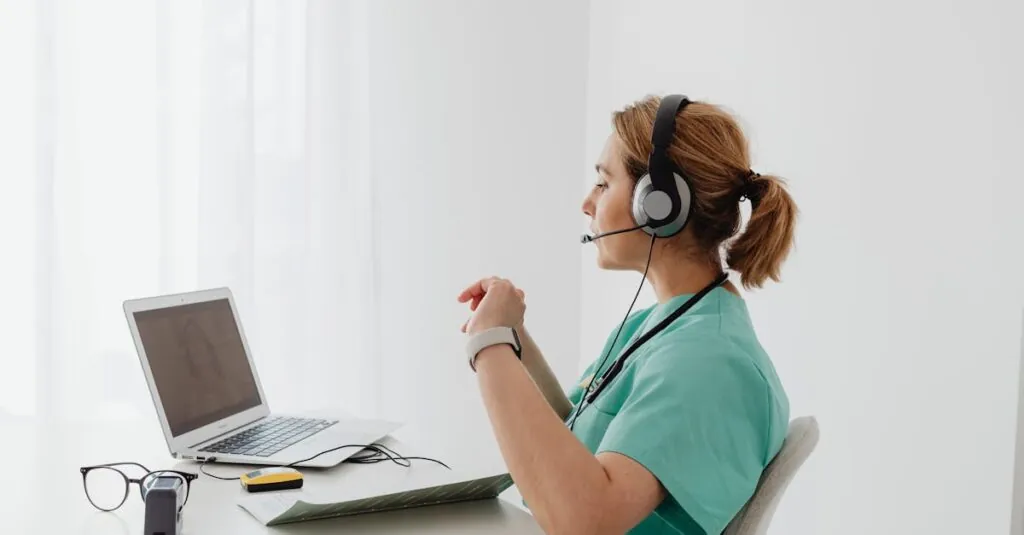Table of Contents
ToggleIn the fast-paced world of healthcare, nurse call buttons are the unsung heroes, silently waiting to save the day. Imagine being in a hospital bed, trying to summon help while juggling a million thoughts. That little button becomes a lifeline, transforming panic into peace of mind. It’s like having a superhero in your pocket—minus the cape, of course!
Overview Of Nurse Call Buttons
Nurse call buttons serve as essential devices in healthcare environments. Patients depend on these tools to request immediate assistance from medical staff. Each button connects patients to nurses, ensuring prompt responses to urgent needs.
Typically mounted near beds, call buttons are designed for easy access. Their presence reduces anxiety, allowing individuals to feel safe and supported. Various types of buttons exist, including wired and wireless options.
Medical facilities often implement sophisticated systems integrating audio and visual alerts. These systems enhance communication by providing feedback when a call is placed. Clear audio signals notify nurses of requests, while visual indicators are helpful in busy areas.
Nurse call systems contribute to improved patient outcomes. Research shows that timely responses to calls can lead to higher satisfaction levels. Studies also indicate that using these systems effectively can enhance patient safety.
In addition to individual buttons, advanced monitoring systems track patient requests. These systems analyze data, helping hospitals identify patterns in call usage. Understanding these patterns fosters better resource allocation for nursing staff.
Regular maintenance of nurse call buttons is crucial for optimal operation. Hospitals must routinely check and service these devices to prevent failures. Training staff on the importance and functionality of the system plays a vital role in ensuring effectiveness.
Nurse call buttons not only support patient care but also create an environment that prioritizes safety and responsiveness. They embody the commitment of healthcare providers to deliver high-quality service.
Importance Of Nurse Call Buttons
Nurse call buttons play a critical role in patient care within healthcare settings. They directly influence both safety and communication between patients and medical staff.
Enhancing Patient Safety
Patient safety remains a top priority in hospitals. Call buttons empower patients to summon help instantly during emergencies. Immediate access to assistance mitigates risks, leading to quicker intervention when complications arise. Studies suggest prompt responses significantly reduce adverse outcomes. In facilities utilizing these systems, patients report higher satisfaction levels, often attributing their sense of security to their ability to reach staff when necessary. Nurse call buttons establish a safety net, ensuring that help is always within reach, which directly impacts overall patient well-being.
Improving Communication
Effective communication between patients and staff is essential for quality care. Nurse call buttons facilitate real-time interaction, allowing patients to express their needs without delay. Systems incorporating audio and visual alerts enhance this process, promoting clarity in communication. Consequently, these tools encourage timely responses from healthcare professionals, reducing misunderstandings and enhancing the care experience. Hospitals dedicated to improving communication strategies find that they foster stronger relationships with patients, which further enhances satisfaction and trust. Prioritizing effective communication through call buttons ultimately leads to improved health outcomes and a more responsive care environment.
Types Of Nurse Call Buttons
Nurse call buttons come in various types, each designed to meet specific needs within healthcare settings. Understanding these options helps facilities choose the most effective systems for their patients.
Wireless Nurse Call Systems
Wireless nurse call systems offer flexibility and convenience. They eliminate the need for extensive wiring, which streamlines installation. Many of these systems utilize radio frequency technology to transmit signals, allowing patients to call for help from anywhere within the facility. Portability enhances patient independence, enabling them to carry personal call devices. Facilities can also expand wireless networks easily, adapting to evolving needs. Research indicates hospitals utilizing wireless systems often experience quicker response times, improving overall patient satisfaction.
Wired Nurse Call Systems
Wired nurse call systems remain a reliable choice in many care environments. These systems utilize direct connections, ensuring consistent communication between patients and staff. They often feature robust audio and visual alerts, helping to capture the attention of healthcare personnel promptly. Installation involves running cables throughout the facility, which may require more time and planning. Wired systems generally provide stability and reduce the likelihood of interference. Facilities benefit from rigorous data tracking capabilities, enhancing their ability to monitor patient calls effectively.
Features To Consider
Selecting the right nurse call button involves evaluating specific features that enhance functionality and user experience.
Ease Of Use
Users prioritize ease of use when selecting nurse call buttons. Buttons should be intuitive, allowing patients to summon help quickly and effortlessly. Designs incorporate large, well-marked buttons that are easily accessible from a lying position. Patients, especially those with mobility challenges, benefit from simple pressing mechanisms. Color coding can also assist patients in identifying their call button among other devices. Research indicates that a user-friendly interface leads to faster responses from healthcare staff, contributing to improved patient satisfaction.
Integration With Other Systems
Integration with other systems enhances the effectiveness of nurse call buttons. Many advanced systems connect seamlessly with electronic health records (EHR) and nurse workstations. This connectivity allows for real-time updates on patient needs, ensuring that medical staff receive notifications promptly. Integration with visual and audio alert systems further amplifies communication efficiency, reducing misunderstandings. Choosing nurse call buttons that can interface with these technologies supports a holistic approach to patient care, ultimately resulting in better health outcomes and streamlined operations within healthcare facilities.
Impact On Healthcare Efficiency
Nurse call buttons significantly enhance healthcare efficiency by streamlining communication between patients and medical staff. Immediate access to assistance reduces response times during critical situations, enabling timely interventions. Facilities that implement these systems often see improved workflow, as staff can prioritize needs based on call urgency.
Data shows that effective call button usage correlates with higher patient satisfaction rates. Improved communication channels foster trust between patients and healthcare professionals. By empowering patients to signal their needs instantly, healthcare providers can minimize anxiety and create a more responsive environment.
Different types of nurse call systems offer unique advantages. Wireless call buttons provide flexibility, allowing patients to reach staff from various locations within the facility. In contrast, wired systems deliver consistent reliability through direct connections, which supports effective data tracking.
Key features contribute to maximizing the efficiency of nurse call buttons. Intuitive interfaces ensure that patients can easily access support, particularly helpful for those with mobility issues. Systems that integrate with electronic health records facilitate real-time updates, ensuring staff receive timely notifications about patient needs.
Finally, prioritizing effective communication through nurse call buttons leads to better health outcomes. Staff equipped to respond swiftly can address needs more efficiently, ultimately enhancing overall patient care and safety. With reliable systems in place, healthcare facilities demonstrate a commitment to quality service, showcasing how essential these tools are in today’s healthcare landscape.
Conclusion
Nurse call buttons are indispensable tools in healthcare settings that significantly enhance patient safety and communication. Their ability to provide immediate access to assistance fosters a sense of security for patients during vulnerable moments. By integrating user-friendly designs and advanced technology, these systems empower patients to communicate their needs effectively.
The impact of nurse call buttons extends beyond immediate care. They streamline workflows for medical staff and contribute to higher patient satisfaction rates. As healthcare facilities continue to prioritize these systems, they reinforce their commitment to delivering high-quality care. Ultimately, investing in reliable nurse call button systems is essential for creating a responsive and supportive healthcare environment.




